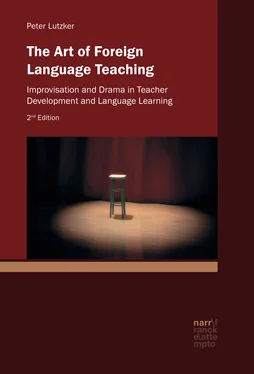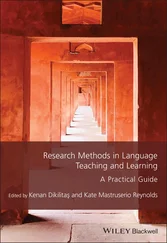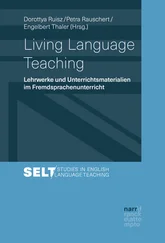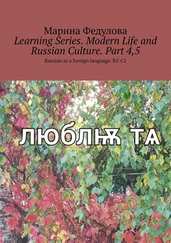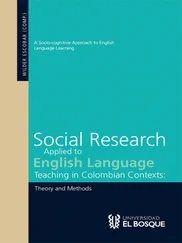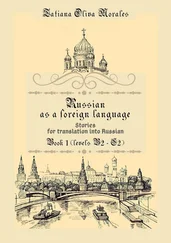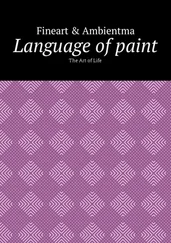Although the time-structure of each day’s sessions may vary considerably, there is a general framework present. In the three hour workshop, this first warm-up phase generally lasts at least an hour, and on the first days often longer. In the next phase people get to choose from a wide range of contemporary poems which he has read to the group on the first or second day, and then work in groups of three or four on creating ‘group performances’ of those poems. At the end of the week the poems are performed for the other participants and in some cases are presented in front of the whole conference at the final plenary session.
The groups are given complete freedom to experiment with their own ways of working on and presenting the poems. Since the warm-up phase strongly emphasizes creatively exploring the movements and sounds of words, the group processes and performances usually evidence many elements of this type of work. The final presentations can be quite dramatic, uninhibited, and surprising. One of the participants wrote down her recollections of working on a Dylan Thomas poem in an article:
Robert McNeer built up such a trust and environment for safe experimentation with the spoken word that possibly our teaching approaches will never be quite the same again. We played with words, throwing them around the room, sometimes in chorus, sometimes merging in curious indefinable sound and sometimes like arrows, striking a specific point. We pulled Dylan Thomas’ “Fern Hill” off the page and played around ‘the lilting house, happy as the grass was green’!198
The phase of working in small groups usually lasts between 45–60 minutes. The last part of the workshop (45–60 minutes) is devoted to individual readings. All participants have been asked to come prepared with individual material; generally poems are chosen, sometimes a monologue from a play. With the other participants sitting in a half circle as an audience, each participant in the course of the week recites or speaks his or her prepared material to the group. In an open-class situation, McNeer then works with them on their material while the others not only get to observe the process, but are often asked to actively take part through reporting to the participants what they are perceiving as changes and transformation. He writes,
Part of the work involves individual presentation of a piece of literature, usually a poem. This gives us the opportunity to analyse in some depth the qualities of each individual. This is always fascinating work and often quite moving. Watching the others, one is invited to go as deeply as possible into what is perceived regarding the performer’s energy, regarding the vehicle which transmits the poem.199
Over the years what has remained most constant in this work is that many teachers seem to have a set image of what a good public reading should sound and look like, i.e. the kind of voice qualities and gestures that are necessary in performing literature for others. The effect of this, put simply, is that there is generally a good deal of ‘overacting’. The process through which these extraneous qualities begin to disappear and the poem and the ‘real’ person seem to gradually emerge can often be a very moving and mysterious process for both the participant and the observers. McNeer describes this from his perspective:
In a calm, accepting atmosphere, the observers are often capable of reading extremely subtle signs, often surprising the performer with what seem like acts of telepathy as they respond to fluctuations in his psychophysical state. (…) Describing, without judging, the qualities of the presentation, we begin to notice that the things that we normally consider defects, such as a thin, weak or grating voice, shallow breathing, or trembling, are simply qualities which, in the right context, can be more expressive of the spirit of the poem than can the resonant but empty voice and cliché gestures to which a false idea of “correct” speaking in public can lead us.200
The nature of the transformations that can occur in this work sometimes in the course of only a few minutes can be breathtaking. These moments are clearly dependent on the entire range of processes in the workshop which have occurred until that point. The essential role of the warm-ups in creating the atmosphere and openness necessary to make such breakthroughs becomes evident in the comments of two participants who later published reports about their experiences in his workshops.
One of the first things we were asked to do was to remove our chairs which we didn’t use again. (…) We were then guided through a spectrum of exercises, done alone or in pairs or as a group that are useful for our own practical everyday use when teaching. There were warming-up exercises and a lot of body work to do away with tension and make it possible to approach learning, teaching and reciting in a different way. Robert McNeer, an American multilingual actor, who lives in Italy, took us off into a world of speech and sound, hearing and feeling, of letting go and of having to pluck up courage (…) in a very pleasant and loving atmosphere that made it possible for us to go out of ourselves and get more a taste of what the artist in us could be like.201
During the workshops, Robert sometimes put us into situations that made us feel vulnerable, demanded courage of us, took us to what we imagined to be the limit and then he guided us lovingly through, to new places we were happy to explore. We made all kinds of discoveries for ourselves and with others because he made it safe for us. This is surely what we want to aim for in each of our students through their experiences in English learning.202
For the other participants in the group watching these transformations occur, there is sometimes the feeling of taking part in a highly personal and existential process. As the reading begins to gain clarity and expressiveness, the group simultaneously witnesses the transformation of both the reader and the poem. Despite the intimacy of the coaching process, the group remains not only closely connected to what is happening, but often becomes through its very presence a prime catalyst for the decisive steps that are being made. McNeer writes,
This is work which takes place, and which can only take place, in “public” that is, in front of the others. It leads to subtle and sometimes quite profound breakthroughs regarding one’s ability to express oneself, regarding, in fact, one’s self-image. Through the eyes of the others, one discovers that there is nowhere to hide, but also no need to do so. The others inevitably see all that one thinks to hide, but they also see beyond that, somewhere deeper, to where the profound need to express oneself resides. Through the gaze of the other, we see ourselves anew. At this point we can stop wasting energy on the attempt to conceal and repress that which we considered “flaws”, stop trying to imitate an external, rigid and generic “right form” and begin to enjoy being ourselves and discovering the side of our self which can respond most appropriately to the opportunity which the moment offers.203
It is one of the basic tenets underlying the English Week that such experiences of performing literature can have profound and wide-ranging effects on the participants – all of whom are English teachers and not actors. What also becomes apparent is that these workshops offer a remarkable opportunity for teachers to assume the role of the learner and to be taught by an enormously sensitive and capable artist. An essential characteristic of all the workshops that I have witnessed is that he is not working with the teachers as a director , but as a teacher . This means that one never has the feeling that he is aiming for the realization of his specific conception of a particular poem, story, or scene. His priority lies solely in fostering a process within each teacher which will let that person more completely express their own relation to what they have prepared. His goal remains (as he has sometimes titled his workshops), to reveal ‘the artist within’. For teachers being able to observe this, his work can function as a kind of paradigm of what teaching can be; in itself, a revealing and inspiring process.204
Читать дальше
